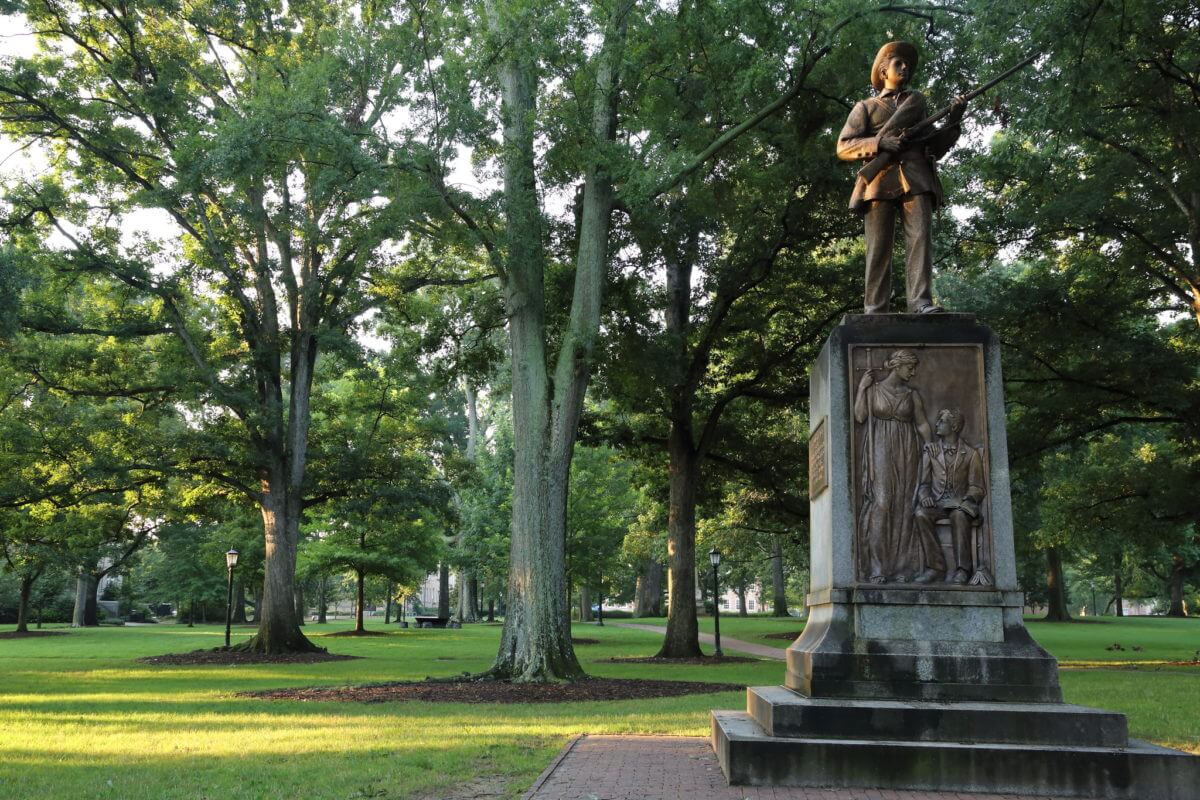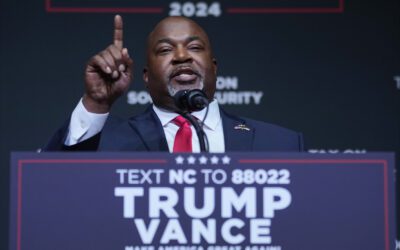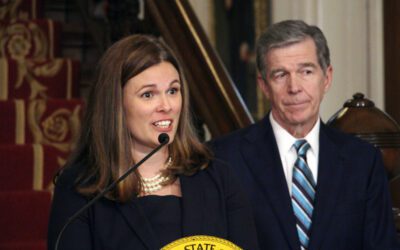
The University of North Carolina System struck a deal to transform ownership of the statue to the Sons of Confederate Veterans. A judge threw that deal out last week.
The Confederate Civil War monument known as Silent Sam hasn’t stood on the UNC Chapel Hill campus since 2018, when it was pulled to the ground by protesters after years of complaints. Two years later, it’s still unclear what will happen to the controversial statue of a Confederate soldier clutching a gun and gazing into the distance.
Last November, the governing body of the University of North Carolina System struck a deal with the Sons of Confederate Veterans (SCV) to transfer ownership of the statue to the group. The Board of Governors also agreed to provide a $2.5 million trust for its display and upkeep.
That deal was voided last week by Superior Court Judge Allen Baddour.
Here’s what you need to know about how this situation came to a head, is still unfolding, and what might happen next.
Decades of controversy
Students and community leaders had voiced concerns with Silent Sam for years. Demonstrations and other actions calling for its removal date back decades.
While defenders of the statue argue removing such monuments is tantamount to erasing history, those on the other side of the debate say they were put up to instead push the “lost cause” narrative and intimidate freed African Americans.
In 2009, historian, professor, and author Adam Domby (The False Cause: Fraud, Fabrication, and White Supremacy in Confederate Memory), then a graduate student at UNC Chapel Hill, discovered among the university’s papers a speech industrialist and white supremacist Julian Carr gave on the day the monument was unveiled in 1913.
Carr proudly recounted a time he whipped a Black woman, for allegedly insulting a white woman, “until her skirts hung in shreds.”
Domby publicized the speech and its context in a letter to the editor, and student organizers once again ramped up efforts to get rid of Silent Sam.
“Arguments that [Civil War] monuments have nothing to do with white supremacy are frankly ahistorical to begin with,” Domby told COURIER. “The argument that monuments teach history is also false.”
Domby said he doesn’t need monuments to teach about the Civil War or the Jim Crow era that followed. “You don’t learn history from a monument. You learn history from a book.”
Efforts to rid the campus of the monument intensified after white nationalists marched through Charlottesville in 2017 to protest against the planned removal of a Robert E. Lee statue. An anti-racist counterdemonstrator, Heather Heyer, was struck by a car and killed, and President Donald Trump made a now infamous speech in which he said there were “good people on both sides.”
Students finally said “No more”
Activist and UNC Chapel Hill alum Kristen Marion, who told COURIER she was there when Silent Sam came down, said she directly credits the Charlottesville incident with what happened at UNC Chapel Hill the following year.
“Heather Heyer passing away definitely, I believe, one thousand percent contributed to the removal of Silent Sam,” she said.
The official university statement from then-UNC Chancellor Carol Folt noted Silent Sam had “been divisive for years, and its presence has been a source of frustration for many people not only on our campus but throughout the community.” She also called the actions of protesters “unlawful and dangerous.”
Folt would later go on to apologize for the university’s history of slavery and ordered the removal of the pedestal on which the statue had stood.
Searching for solutions
Decisions concerning what to do next were complicated by a state law passed in 2015 banning the removal or relocation of “objects of remembrance” on public property, except in limited cases.
The United Daughters of the Confederacy have challenged actions in other parts of the state removing Civil Rights monuments as ordered by local officials, arguing that doing so violated the law. At issue in both cases is who owns the monument. That’s not the case with Silent Sam, but it remains to be seen if the law will be read as commanding its return to the public university’s grounds.
Prior to the removal of the statue by protesters, Gov. Roy Cooper said it was his opinion that Silent Sam could be removed if the university felt there was an “imminent threat” that could result from keeping it up, after UNC officials asked him to convene the state Historical Commission to consider the issue.
A questionable deal
The Board of Governors thought they had found the perfect solution: turn the statue over to the SCV and let them decide where to display it, provided it wasn’t on or too near a college campus, and be in charge of its upkeep.
Critics have characterized the situation as a backroom deal with a white nationalist organization.
The details of the plan, which were not publicly discussed and announced the day before Thanksgiving, certainly raised eyebrows. The terms were approved before the SCV filed a lawsuit claiming ownership. The SCV and the Board of Governors then agreed to a settlement based upon that claim, which was signed off on by Baddour, the same judge who overturned the deal.
The details were uncovered by attorney and former Board of Governors member T. Greg Doucette, who quickly publicized his findings in a Twitter thread.
Doucette noted that SCV did not appear to have standing to bring a suit, as it did not own the monument as claimed.
A number of prominent alumni and donors then joined a legal brief arguing the deal constituted a “misuse of University funds.”
The brief said the complainants felt the settlement “seriously damages the reputation of the University, which should be committed to historical truth and opposed to modern-day white supremacy.”
As noted, Baddour then ruled SCV had no standing to bring the suit, and thus threw out the settlement and dissolved the trust that would have granted the group the $2.5 million.
Now what?
On Thursday, Baddour issued a 45-day deadline for the Sons of Confederate Veterans to return the monument to UNC, and ordered that the group return the remaining balance of a $2.5 million trust fund within 10 days.
What happens next is anyone’s guess. Board of Governors chairman Randy Ramsey said the monument, once it’s returned, will not be the board’s primary focus for the time being. “We will secure the monument away from campus, and we will deal with it in due course,” he said.

Op-Ed: Studying the Holocaust remains vital to ensuring it never happens again
International Holocaust Day will be observed on January 27, 2024. This day commemorates the liberation of the Auschwitz concentration camp by the...

VIDEO: How Rural Broadband Is Coming to This North Carolina County
More than 1.1 million North Carolinians lack access to high-speed internet, a necessity of the modern economy. In Warren County, help is on the way,...

VIDEO: Sampson County puts Biden’s promise to boost rural infrastructure to the test
Locals in this rural NC county say their water and air is polluted by a PFAS-contaminated landfill, massive hog and poultry farms, and industrial...

VIDEO: Sampson County puts Biden’s promise to boost rural infrastructure to the test
Locals in this rural NC county say their water and air is polluted by a PFAS-contaminated landfill, massive hog and poultry farms, and industrial...

Mold and classes in trailers: Inadequate funding for schools is hurting NC communities
Schools across the state are dealing with dilapidated classrooms and buildings in need of significant repair or a total rebuild due to a lack of...







